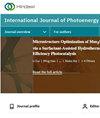整合太阳能光伏电源和沼气能源系统,增加坦桑尼亚农村地区的电力供应
IF 2.1
4区 工程技术
Q3 CHEMISTRY, PHYSICAL
引用次数: 3
摘要
可再生能源是应对自然资源减少和能源短缺挑战的最佳选择。由于太阳能的巨大潜力,利用太阳能光伏系统是消除坦桑尼亚能源短缺的最佳选择。动物粪便是农村地区废物的重要来源,可以通过厌氧过程转化为沼气燃料。畜牧业和农业在经济上极大地支持了包括坦桑尼亚在内的撒哈拉以南非洲(SSA)地区的大多数农村人口,牛的排泄物有利于沼气燃料的生产。不幸的是,动物粪便发电的高潜力没有得到充分利用。整合太阳能和动物粪便中的沼气燃料有助于缓解能源短缺、电力不稳定和环境问题。坦桑尼亚环境中用于农村电气化应用的离网太阳能光伏-沼气混合微电网系统有限,而且大多数研究都是使用软计算工具进行的,尤其是使用人工智能优化技术应用有限的多能源混合优化(HOMER)软件。本文对坦桑尼亚姆贝亚地区Simboya村的混合可再生能源供应系统(HRESS)进行了技术经济可行性分析。设计并优化了离网HRESS,以满足使用HOMER软件和灰狼优化(GWO)方法执行的所选位置的负载。微电网预计将提供63.41的每日最大需求 kW。住宅负荷分布等于30 kW,占日需求的50%。HOMER平台的优化结果表明,该系统的总净现值成本(NPC)和平准化能源成本(LCOE)分别为106383.50美元和0.1109/kWh。此外,本文还给出了GWO方法在不同电力损失概率(LEPP)值下的优化和灵敏度分析结果。基于LEPP值0、0.04和0.06的总NPC和LCOE分别为85106.8美元、79545.99美元和71747.36美元,以及0.0887美元/千瓦时、0.0316美元/千瓦小时和0.0102美元/千瓦时候。HRESS在经济上和环境上都有利于为选定地区和世界范围内的类似情况供电。本文章由计算机程序翻译,如有差异,请以英文原文为准。
Integrating Solar Photovoltaic Power Source and Biogas Energy-Based System for Increasing Access to Electricity in Rural Areas of Tanzania
Renewable energy is the best option for the challenge of dwindling natural resources and energy scarcity. The utilization of solar photovoltaic (PV) systems is the best option for eliminating the energy deficit in Tanzania due to the available great potential of solar energy. Animal manure is a significant source of waste in rural locations which can be transformed into biogas fuel by an anaerobic process. Livestock and agriculture greatly support economically the majority of the sub-Saharan African (SSA) region’s rural population including Tanzania, and excreta from cattle are beneficial for biogas fuel production. Unfortunately, the high potential of animal waste for generating electricity is underutilized. Integrating solar energy sources and biogas fuel derived from animal manure is useful for mitigating energy shortage, power instability, and environmental issues. Off-grid solar PV biogas-based hybrid microgrid systems for rural electrification applications in the Tanzanian environment are limited, and also, most of the studies are extensively carried out using soft computing tools especially hybrid optimization of multiple energy resources (HOMER) software with limited applications of artificial intelligence (AI) optimization techniques. This paper presents technoeconomic viability analysis for a hybrid renewable energy supply system (HRESS) for the Simboya village in Mbeya region, Tanzania. Off-grid HRESS is designed and optimized to meet the load of the chosen location executed using HOMER software and the grey wolf optimization (GWO) method. The microgrid is anticipated to supply daily maximum demand of 63.41 kW. The residential load profile equals 30 kW representing 50% of the daily demand. Optimization results by the HOMER platform indicate that the system has a total net present cost (NPC) and levelized cost of energy (LCOE) of $106,383.50 and $0.1109/kWh, respectively. Furthermore, this paper presents the optimization and sensitivity analysis results acquired by the GWO method under varied values of Loss of Electrical Power Probability (LEPP). Total NPC and LCOE based on LEPP values of 0, 0.04, and 0.06 are $85,106.8, $79,545.99, and $71,747.36 and $0.0887/kWh, $0.0316/kWh, and $0.0102/kWh, respectively. HRESS is economically and environmentally beneficial for supplying electricity to the selected area and worldwide in similar situations.
求助全文
通过发布文献求助,成功后即可免费获取论文全文。
去求助
来源期刊
CiteScore
6.00
自引率
3.10%
发文量
128
审稿时长
3.6 months
期刊介绍:
International Journal of Photoenergy is a peer-reviewed, open access journal that publishes original research articles as well as review articles in all areas of photoenergy. The journal consolidates research activities in photochemistry and solar energy utilization into a single and unique forum for discussing and sharing knowledge.
The journal covers the following topics and applications:
- Photocatalysis
- Photostability and Toxicity of Drugs and UV-Photoprotection
- Solar Energy
- Artificial Light Harvesting Systems
- Photomedicine
- Photo Nanosystems
- Nano Tools for Solar Energy and Photochemistry
- Solar Chemistry
- Photochromism
- Organic Light-Emitting Diodes
- PV Systems
- Nano Structured Solar Cells

 求助内容:
求助内容: 应助结果提醒方式:
应助结果提醒方式:


